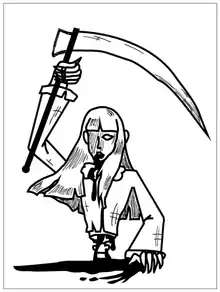Teke Teke
Teke Teke (テケテケ;てけ てけ),[1] also spelled Teke-Teke,[2] Teketeke,[3] or Teke teke,[1] is a Japanese urban legend about the ghost of a schoolgirl who is said to have fallen onto a railway line, where her body was cut in half by a train. She is an onryō, or a vengeful spirit, who lurks in urban areas and around train stations at night. Since she no longer has a lower body, she travels on her hands, dragging her upper torso and making a scratching or "teke teke"-like sound, produced either by her elbows or the end of her bisected body scraping the ground. If she encounters an individual, she will chase them and slice them in half at the torso, killing them in such a way that mimics her own disfigurement.[4]

Overview
Common elements of the legend include that Teke Teke is the vengeful ghost or spirit (also known as an onryō) of a young woman or schoolgirl who fell on a railway line in Northern Japan, which resulted in her being sliced in half by a train. Missing her lower extremities, she is said to walk on her hands or her elbows, making a scratching or "teke teke"-like sound as she moves. If an individual encounters Teke Teke at night, she will chase them and cut their body in half (often with a scythe), mimicking her own death and disfigurement.
One version of the story concerns a young woman known as Kashima Reiko. As with the original iteration of the legend, Kashima died when her legs were severed from her body by a train after she fell on the tracks.[5][6] According to some sources, some versions of the legend state that, when an individual learns of Kashima's story, she will appear to them within one month. The "Kashima Reiko" story predates that of Teke Teke.[7] The legless spirit of Kashima Reiko is said to haunt bathroom stalls, asking occupants if they know where her legs are.[5] If a questioned individual replies with an answer that Kashima does not find acceptable, she will rip or cut their legs off.[8] Individuals may survive the encounter by replying that her legs are on the Meishin Expressway,[8][9] or by responding with the phrase "kamen shinin ma", or "mask death demon" (which may be the phonetic root of Kashima's name).[8][10] The legend of Kashima Reiko has been described as a "bathroom-centric variation" of Teke Teke.
See also
- Aka Manto ("Red Cape"), a Japanese urban legend about a spirit that appears in bathrooms.
- Hanako-san, a Japanese urban legend about the spirit of a young girl who haunts school bathrooms.
- Kuchisake-onna ("Slit Mouth Woman"), a Japanese urban legend about a disfigured woman.
- Madam Koi Koi, an African urban legend of a ghost who haunts schools.
- Sadako Yamamura, a ghost from the Ring novels and films.
- Teketeke (film), a 2009 film based on the urban legend.
- TEKE::TEKE, a Canadian rock group.
References
- Meyer, Matthew (31 October 2015). "Teke teke". Yokai.com. Retrieved 12 July 2019.
- "Teke-Teke - Japanese Urban Legends". ScaryForKids.com. 24 November 2014. Retrieved 12 July 2019.
- Murguía 2016, p. 317.
- de Vos 2012, p. 170.
- Meza-Martinez, Cecily; Demby, Gene (31 October 2014). "The Creepiest Ghost And Monster Stories From Around The World". NPR. National Public Radio, Inc. Retrieved 6 August 2019.
- Fierro, Romina. "Teke Teke: el fantasma japonés que aterra a quienes caminan por las estaciones de tren" [Teke Teke: the Japanese ghost that terrifies those who walk through train stations]. Vix.com. Retrieved 6 August 2019.
- "Japanese Urban Legends: Kashima-san | Kowabana". 30 June 2018. Retrieved 19 February 2021.
- Grundhauser, Eric (2 October 2017). "Get to Know Your Japanese Bathroom Ghosts". Atlas Obscura. Retrieved 12 July 2019.
- Bricken, Rob (19 July 2016). "14 Terrifying Japanese Monsters, Myths And Spirits". Kotaku. G/O Media. Retrieved 6 August 2019.
- Bathroom Readers' Institute 2017, p. 390.
Further reading
- Bathroom Readers' Institute (2017). Uncle John's OLD FAITHFUL 30th Anniversary Bathroom Reader (Uncle John's Bathroom Reader Annual). Portable Press. ISBN 978-1684120864.
- de Vos, Gail (2012). What Happens Next? Contemporary Urban Legends and Popular Culture. Libraries Unlimited. ISBN 978-1598846331.
- Murguía, Salvador Jimenez (2016). The Encyclopedia of Japanese Horror Films (National Cinemas). Rowman & Littlefield Publishers. ISBN 978-1442261662.